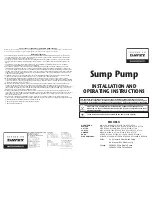
2
INSTALLATION
IMPORTANT
: Effective January 1, 2015, all split system and
packaged air conditioners must be installed pursuant to applicable
regional efficiency standards issued by the Department of Energy.
CUT HAZARD
Failure to follow this caution may result in personal injury.
Sheet metal parts may have sharp edges or burrs. Use care and
wear appropriate protective clothing and gloves when
handling parts.
CAUTION
!
Check Equipment and Job Site
Unpack Unit
Move to final location. Remove carton taking care not to damage
unit.
Inspect Equipment
File claim with shipping company prior to installation if shipment
is damaged or incomplete. Locate unit rating plate on unit corner
panel. It contains information needed to properly install unit.
Check rating plate to be sure unit matches job specifications.
Install on a Solid, Level Mounting Pad
If conditions or local codes require the unit be attached to pad, tie
down bolts should be used and fastened through knockouts
provided in unit base pan. Refer to unit mounting pattern in Fig. 2
to determine base pan size and knockout hole location.
For hurricane tie downs, contact distributor for details and PE
Certification (Professional Engineer), if required.
On rooftop applications, mount on level platform or frame. Place
unit above a load--bearing wall and isolate unit and tubing set from
structure. Arrange supporting members to adequately support unit
and minimize transmission of vibration to building. Consult local
codes governing rooftop applications.
Roof mounted units exposed to winds above 5 mph (8.05 km/h)
may require wind baffles. Consult the Service Manual --
Residential Split System Air Conditioners and Heat Pumps for
wind baffle construction.
NOTE
: Unit must be level to within
±
2
°
(
3/8 in./ft,
9.5 mm/m.)
per compressor manufacturer specifications.
CAUTION
!
UNIT OPERATION HAZARD
Failure to follow this caution may result in equipment
damage or improper operation.
Locate the unit in such a way that it is stable in all
circumstances including adverse weather conditions.
Clearance Requirements
When installing, allow sufficient space for airflow clearance,
wiring, refrigerant piping, and service. Allow 24 in. (609.6 mm)
clearance to service end of unit and 48 in. (1219.2 mm) (above
unit. For proper airflow, a 6--in. (152.4 mm) clearance on 1 side of
unit and 12--in. (304.8 mm) on all remaining sides must be
maintained. Maintain a distance of 24 in. (609.6 mm) between
units. Position so water, snow, or ice from roof or eaves cannot fall
directly on unit.
On rooftop applications, locate unit at least 6 in. (152.4 mm)
above roof surface.
3/8---in. (9.53 mm) Dia.
Tiedown Knockouts in
Basepan(2) Places
View From Top
UNIT BASE PAN
Dimension in. (mm)
TIEDOWN KNOCKOUT LOCATIONS in. (mm)
A
B
C
35 X 35
(889 X 889)
9–1/8 (231.8)
6–9/16 (166.7)
28–7/16 (722.3)
A05177
Fig. 2 -- Tiedown Knockout Locations
Operating Ambient
The minimum outdoor operating ambient in cooling mode is 55
°
F
(12.78
°
C) without accessories and as low as 0
_
F (--17.78
_
C) with
approved low--ambient accessory kits, and the maximum outdoor
operating ambient in cooling mode is 120
°
F (48.89
°
C). The
maximum outdoor operating ambient in heating mode is 66
°
F
(18.89
°
C).
NOTE
: Units operating at high stage operation, 208v (or below)
line voltage, and at an outdoor ambient of 120
°
F (48.9
°
C) (or
greater), may experience compressor thermal trip.
Check Defrost Thermostat
Check defrost thermostat to ensure it is properly located and
securely attached. There is a liquid header with a brass distributor
and feeder tube going into outdoor coil. At the end of the one of
the feeder tubes, there is a 3/8 in. O.D. stub tube approximately 2
in. long. (See Fig. 3.) The defrost thermostat should be located on
stub tube. Note that there is only one stub tube used with liquid
header, and on most units it is the bottom circuit.
FEEDER TUBE
DEFROST
THERMOSTAT
STUB TUBE
A97517
Fig. 3 -- Defrost Thermostat Location
Elevate Unit
CAUTION
!
UNIT OPERATION HAZARD
Failure to follow this caution may result in equipment
damage or improper operation.
Do not allow water and/or ice to build up in base pan.
Elevate unit per local climate and code requirements to provide
clearance above estimated snowfall level and ensure adequate
drainage of unit.




























